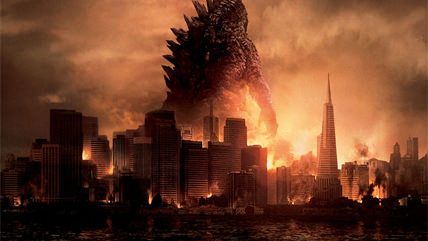Godzilla Brings Monsters To Life
Aaron Taylor-Johnson and Bryan Cranston in a great monster mashup.


There are some familiar themes floating around in the epic wreckage of Godzilla–fathers and sons, maternal devotion, puny humans and their technological insufficiency in the face of undreamt-of natural horrors. All that stuff.
Mainly, though, there are monsters. And they're pretty great.
Gareth Edwards, an English digital-effects specialist, was handed the task of rebooting the 60-year-old Godzilla franchise on the basis of his one previous feature, the micro-budget indie Monsters. He was clearly the man for the job. His updated take on the radioactive behemoth rolled out by the Toho film factory in 1954 is admirably faithful to the atom-age original, from its skyscraper-swatting tail to its earth-shaking roar and iconic blasts of fire-breath. Edwards' Godzilla is taller and bulkier (and maybe angrier) than the Toho prototype. We don't see much of him until the second half of the movie, but when he finally does rumble into view we realize that, compared to the rival leviathans against which he's pitted here, he's actually one of the good guys. Well, apart from his careless disregard for buildings and whatnot.
The story begins in the Philippines in 1999 (the year after the last Godzilla, directed by Roland Emmerich–a dreadful picture to which this one makes no reference). Here we meet two scientists, Serizawa (Ken Watanabe) and Graham (Sally Hawkins), who discover something very big and scary amid the subterranean rubble of a collapsed mine. Meanwhile, at a nuclear plant outside of Tokyo, two other scientists, Joe and Sandra Brody (Bryan Cranston and Juliette Binoche) are worrying about recurrent earth tremors. Higher-ups are dismissing these as simple earthquake aftershocks, but Joe is convinced they're something much worse. He's proven right when whatever it is that's struggling to emerge from underground destroys the whole facility, kills Sandra and leaves Joe a single father to his son, Ford (CJ Adams).
Fifteen years later–now, in other words–Ford (played from this point by Aaron Taylor-Johnson, of the Kick-Ass movies) has grown up to be a Navy ordnance specialist, living in San Francisco with his wife Elle (Elizabeth Olsen) and their own little boy. Ford is called to rejoin his father, who's still living in Tokyo, where the tremors have started up again. Although the site of the old nuclear plant has been under government quarantine ever since its destruction, Joe is convinced this is just a coverup – and once again, he's right. "You have no idea what's coming," he says, with what might in other circumstances be written off as crackpot conviction.
The movie wastes no time in bringing on its two most terrifying creatures, the MUTOs–Massive Unidentified Terrestrial Organisms. These are enormous insectoid reptiles whose razory, goo-dripping teeth strongly recall the titular monstrosity of the Alien movies. The MUTOs have been hatched from "parasitic spores" (whatever) and they feed on radioactive nuclear material – any kind will do. Now they're seeking to mate and reproduce and build a nest somewhere (San Francisco sounds nice). There's a tremendous action scene in Honolulu, with one MUTO rising up out of the sea near an aircraft carrier and triggering a tidal wave that crashes through the city. Then there's a snack break at Nevada's Yucca Mountain nuclear waste repository, followed by a visit to Las Vegas, where the phrase "high roller" acquires new meaning.
By this point, the U.S. Navy has taken charge of the monster situation, and the head officer, Admiral Stenz (David Strathairn), has decided the solution is to just nuke 'em. We know that's the worst possible approach, but when have military men in monster movies ever gotten this sort of thing right?
It's a serviceable story, keeping the action grounded in human feeling. And the actors are fine, even if their characters lack much depth (they say things like "It's not the end of the world" and "Where's Godzilla?"). Director Edwards, however, is all about the action, and he has a real gift for it. The movie offers a thrilling procession of set-piece scenes–chaotic subway attacks, thunderous jungle confrontations–and some spectacular imagery (especially the shots of MUTOs chewing up trains and biting into bridges). And when Godzilla wades into the fray to take on the rampaging MUTOs, a new standard is set for movie monster battles.
What makes the picture so much fun is that, while a lot of what we're seeing is obviously digitally confected, it never feels like standard CGI–we don't get that stale sensation of watching gobs of money being pelted at the screen. Edwards' monsters have weight and dimension–they're convincing in a rare way. And he spares us the usual blockbuster bloat – the movie clocks in at a brisk two hours, and then takes its leave. Edwards will almost certainly be called upon to direct a sequel to this film, and he's been reported to have an eye on remaking the 1968 Toho classic Destroy All Monsters. This would give him an opportunity to reconstitute such vintage creatures as Rodan, Mothra and King Ghidorah–which is to say, what an excellent idea.


Show Comments (34)